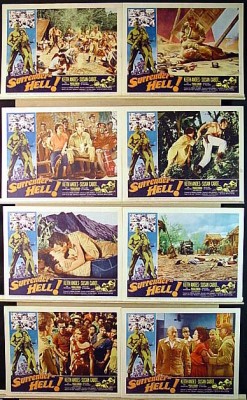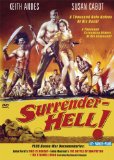| Reviews & Columns |
|
Reviews DVD TV on DVD Blu-ray 4K UHD International DVDs In Theaters Reviews by Studio Video Games Features Collector Series DVDs Easter Egg Database Interviews DVD Talk Radio Feature Articles Columns Anime Talk DVD Savant Horror DVDs The M.O.D. Squad Art House HD Talk Silent DVD
|
DVD Talk Forum |
|
|
| Resources |
|
DVD Price Search Customer Service #'s RCE Info Links |
|
Columns
|
|
|
Surrender-Hell!
Surrender - Hell! has major transfer issues, but if you can get past that the price is right for the documentaries alone; in that sense the feature film ought to be considered the extra feature, with the documentaries the main attraction.
Surrender - Hell! is a low-budget film shot entirely on location in the Philippines, not in the name of authenticity but to get a bigger bang out of the budget. The picture probably cost around $150,000 to make, but in the Philippines that translated to $500,000-$750,000 in production values.
Keith Andes, the prolific television actor best-remembered for his appearances on shows like Star Trek and Perry Mason, stars as Lt. Blackburn. There's not much story but a lot of incident in the 85-minute film. Once the Philippines falls into Japanese hands Blackburn refuses to give up. (In the film he never actually says, "Surrender - Hell!" His line instead is, "Surrender? I didn't quite like it." No, I guess that wouldn't have worked.) He bands together a group of Filipino freedom fighters while a few others, including a shopkeeper and his wife fearful of Japanese retribution, are reluctant to help. This prompts several slightly condescending lectures by the Great White Man on high to the little Asian peasants on the nature of freedom, but these scenes are balanced by his gradual appreciation for the Filipinos' professionalism and bravery. In a neat little scene he later appoints several to ranks equal to his own, much to everyone's surprise.
With support from the U.S. military via airdrops, Blackburn and his Filipino fighting force wreak all manner of havoc; in one scene, for instance, they blow up a strategically important bridge. (This being a low-budget movie, it's a small, rather rickety bridge, but a bridge nonetheless.) Blackburn eventually enlists the aid of three tribes of headhunters, authentic-looking characters who entertain Blackburn with inauthentic-looking tribal dances.
One aspect about the film is quite odd. American actress Susan Cabot (of Wasp Woman fame) gets second-billing as a Filipino refugee Blackburn romances. Cabot obviously went to the Philippines to shoot the film, yet her character basically vanishes just 18 minutes into the picture, not long after her introduction. Right after that, another Filipino woman, Pilar (Paraluman) is introduced, and she also has a romance with Blackburn. What happened? Did Cabot suddenly quit in the middle of production and the script hastily rewritten for another actress?
The film was produced by Edmund Goldman and Paul Schreibman, who had been instrumental in the American release of the first two Godzilla movies, Godzilla, King of the Monsters! and Gigantis - the Fire Monster (1959). Surrender - Hell! is pieced together in a manner that closely resembles that second Godzilla film. Like Gigantis, Surrender - Hell! suffers from almost non-stop narration, about 90% of the total dialogue in fact. It plays like an audio book and its action could easily be followed simply by listening to the soundtrack. I'm surprised you don't hear him counting sheep when Blackburn is sleeping. Some actors are dubbed, some not. One of the looping voices may be George Takei, who also dubbed Gigantis.
And, like Gigantis, the film uses lots of stock shots to beef up the film. There's both military and newsreel footage, and what looks like stock material from a Hollywood movie from the '40s. As Schreibman leased Gigantis to Warner Bros. at around this time, it's reasonable to theorize that perhaps as part of the deal they were granted footage from the Warner Bros. library. (On a completely unrelated note, have you ever noticed that in montages of newspaper headlines there's always a front-page heading reading "Building Code Under Fire?" I guess Hollywood filmmakers always used the same front page template.)
Despite the modest budget, the Filipino crew (including the prolific Gerardo de Leon, credited as editor but possibly an uncredited co-director as well) and cast, many familiar from other movies shot there, give the film an almost-Hollywood polish. It's a respectable production.
Video & Audio
Surrender - Hell! was shot for 1.85:1 projection (or, possibly, 1.66:1; I don't have a definitive answer on this) and presented here in a 16:9 enhanced transfer at 1.78:1. A Kit Parker title, the source material is in okay shape all things considered - some damage here and there, though not bad - but the transfer is another story. It has some of the worst edge enhancement I've ever seen and a headache inducing effect in wide shots that looks like the movie is being projected through a dime store comb. Close-ups and even some medium shots look okay, but since most of the movie was shot in the Philippine jungles, the foliage, etc., really looks quite bad. I watched this on a 45-inch monitor. On small sets these problems may be less glaring than they were for me. The Dolby Digital mono (English only, no subtitles) is adequate.
Extra Features
The Stilwell Road and This is Korea! are real army-supervised flag-wavers, the latter also vehemently anti-communist and originally released by Republic Pictures in not-so-glorious Trucolor. Both documentaries are in very good shape and transferred adequately, far better than the main attraction.
Though not in as good a shape, San Pietro is the real jewel in this crown: John Huston's atypically (for the time) unflinching look at the harsh realities and unspeakable horrors of battle.
Also included is a 4:3 letterboxed trailer ("Living like primitive Adams and Eves! Hiding! Loving!") that's very dark but in some ways looks better than the feature.
Parting Thoughts
Though a mixed bag of material in terms of quality, interest, and video transfers, Surrender - Hell! will appeal to war movie buffs and historians, and the price is so reasonable for the amount of material that it compensates, almost, for the mediocre transfer of the main attraction. (Mildly) Recommended.
Film historian Stuart Galbraith IV's latest book, The Toho Studios Story, is on sale now.
|
| Popular Reviews |
| Sponsored Links |
|
|
| Sponsored Links |
|
|
| Release List | Reviews | Shop | Newsletter | Forum | DVD Giveaways | Blu-Ray | Advertise |
|
Copyright 2024 DVDTalk.com All Rights Reserved. Legal Info, Privacy Policy, Terms of Use,
Manage Preferences,
Your Privacy Choices | |||||||














